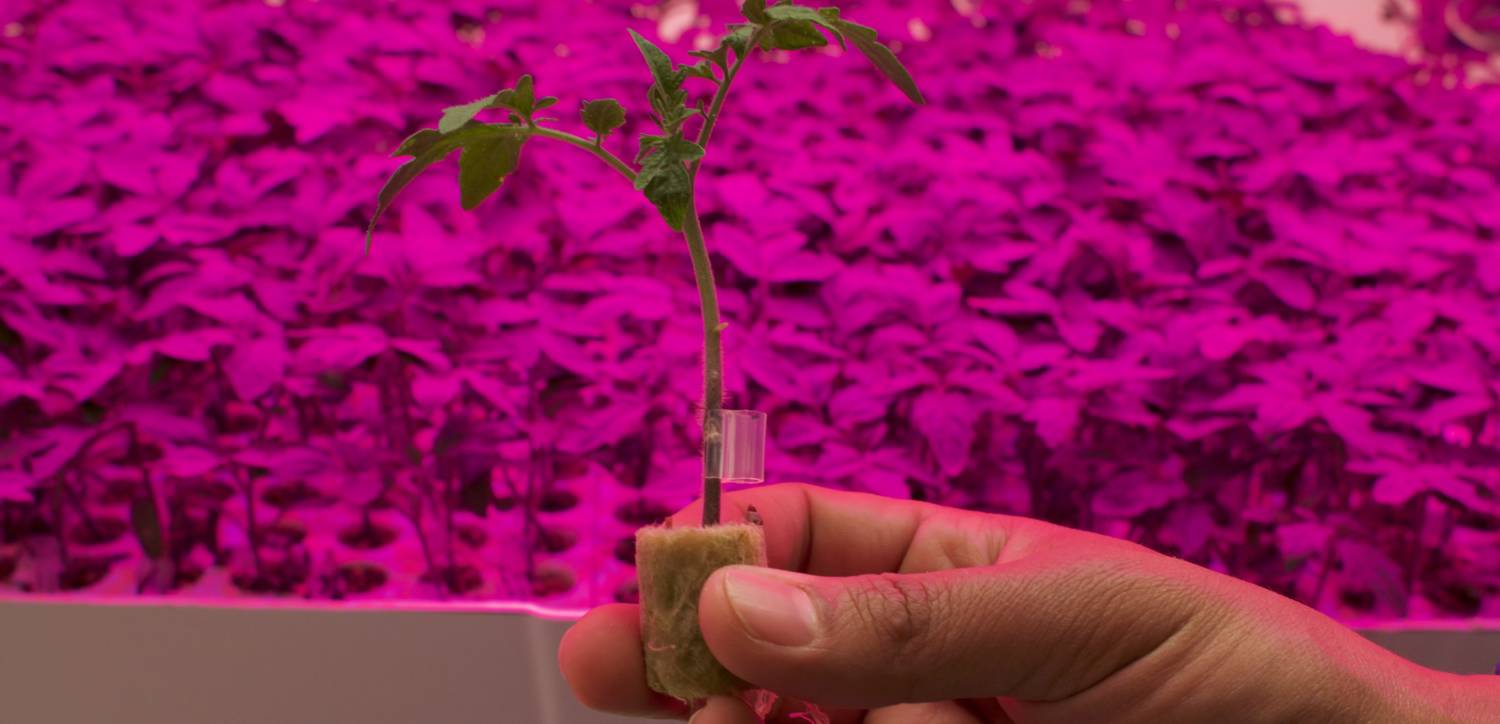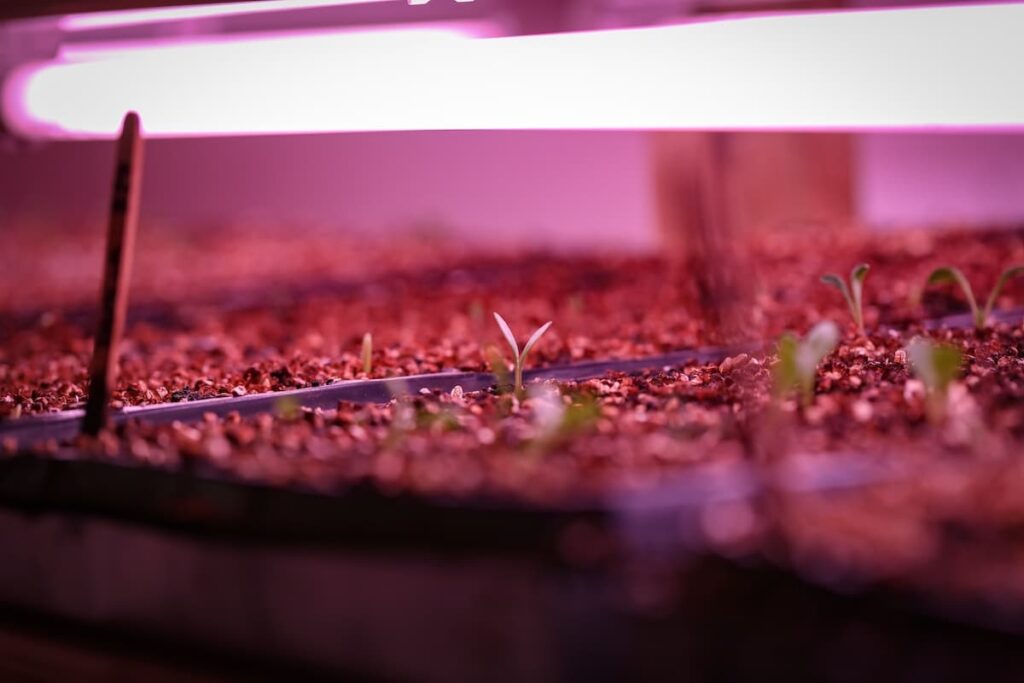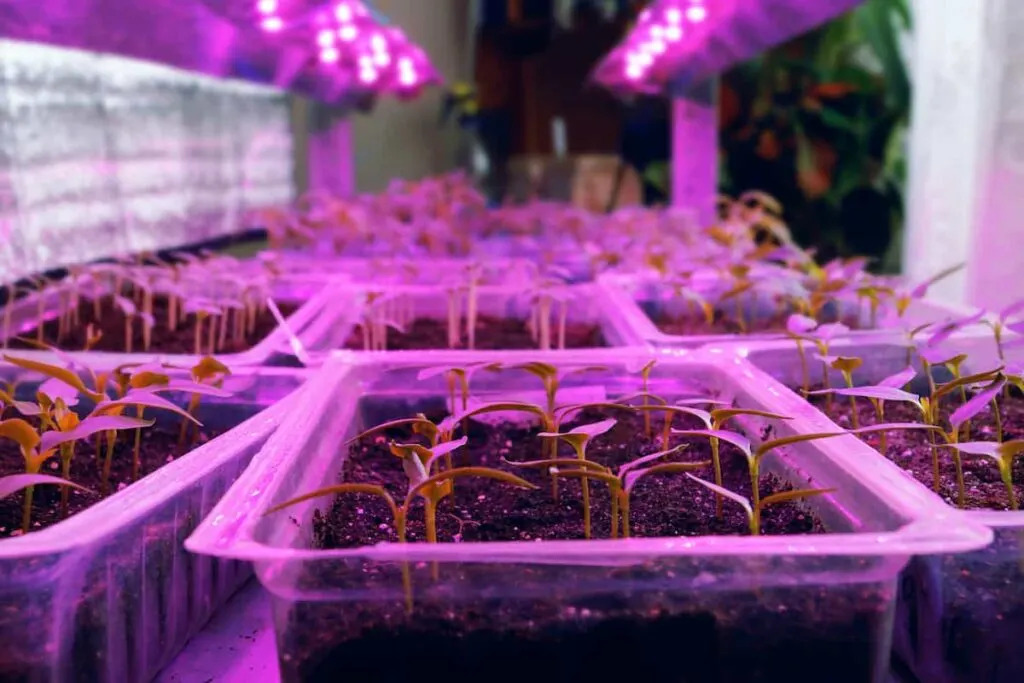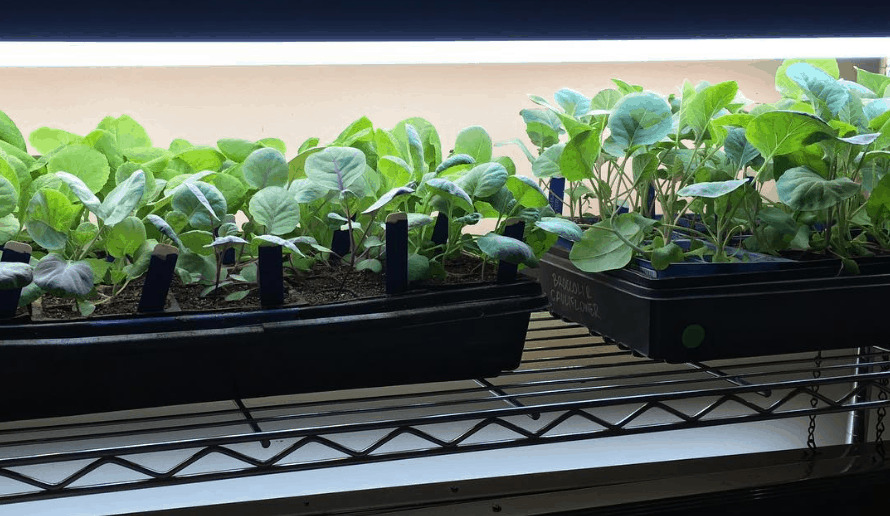Using grow lights to nurture seedlings can be an effective way to ensure healthy growth and yield better results. Grow lights provide the right amount of light needed by seedlings, which cannot always be provided by natural sunlight.
Seedlings that receive sufficient light will grow faster and healthier than those that do not, leading to improved yields and better quality crops. Additionally, using grow lights for seedlings will allow you to control the amount of light they receive, thereby allowing you to create the ideal environment for your plants no matter the season or time of day.
Finally, grow lights are energy efficient and cost-effective compared to other artificial lighting options, making them an ideal choice for growing seedlings indoors. With all these benefits in mind, it’s easy to see why using grow lights for seedlings can be a great way to get your plants off to a strong start!
Types of Grow Lights For Seedlings
When it comes to growing seedlings indoors, there are a variety of grow lights available. Each type of grow light has its own unique benefits and drawbacks that should be taken into consideration when deciding which one is best for your needs. LED grow lights are energy efficient and long-lasting, but may not provide the same spectrum of light as other options.
Budget Option
Mars Hydro LED Grow Light is a great budget option for those who are looking to grow seedlings. With its two feet by two feet coverage area, it gives you the ability to cover plenty of surface and have all of your seedling trays bathed in full-spectrum light.
The white aluminum build also works to reflect light up and further out, doing a great job at emitting more than straight down. This ensures that even the furthest corners of your seedling flat are receiving enough light.
If you’re looking for something affordable yet efficient for your growing needs, Mars Hydro LED Grow Light is definitely worth your consideration. It does an excellent job of evenly distributing light with its large coverage area and reflective design, making it perfect for indoor gardeners and hobbyists alike.
Spider Farmer SF 300 33W Grow Light
The Spider Farmer SF 300 33W Grow Light is a top-of-the-line option for indoor gardening, specifically tailored to meet the needs of seedlings. This energy-efficient grow light provides a wide spectrum of light, including blue light, which is crucial for healthy seedling development.
With its compact design and flexible gooseneck, the Spider Farmer SF 300 can easily be adjusted to provide light to different areas of your seed trays or seedling setup. It emits a bright, full-spectrum light that mimics natural sunlight and promotes optimal growth during the early stages of plant life.
The 33W LED light output ensures that your seedlings receive ample light intensity for strong and sturdy growth. With adjustable light settings, you can customize the light per day depending on the variety of plants you are growing. This versatile grow light can also be used for later stages of plant growth, catering to the needs of mature plants as well.
The Spider Farmer SF 300 offers all these benefits at an affordable price, making it an ideal choice for both beginners and experienced indoor gardeners. Additionally, it features a built-in timer, allowing you to easily set timer settings for the light, providing convenience and peace of mind.
Spider Farmer SF 1000 Grow Light
The Spider Farmer SF 1000 Grow Light is an exceptional choice for seedlings due to its impressive features and functionality. This grow light provides full-spectrum illumination, simulating natural sunlight and enhancing the healthy growth of your seedlings.
One of its standout features is its remarkable energy efficiency. The Spider Farmer SF 1000 consumes less energy compared to traditional fluorescent lights or incandescent bulbs, making it an excellent choice for environmentally-conscious growers.
Additionally, the adjustable dimming option allows you to customize the light intensity according to the specific needs of your seedlings. This flexibility ensures that your plants receive the optimal amount of light during every stage of their growth.
Another advantage of the Spider Farmer SF 1000 is its wide coverage area, which makes it suitable for seedlings in seed trays or small pots. The even light distribution ensures that each seedling receives the necessary light it needs for healthy development.
Fluorescent Bulbs
Fluorescent bulbs are a great choice for seedling growth. Fluorescent bulbs emit a larger spectrum of light than other types of grow lights, which allows them to be used to cultivate both leafy greens and flowering plants.
Additionally, fluorescent bulbs can be found in both cool and warm tones, allowing gardeners to customize the lighting environment for each type of plant they're growing. Fluorescent bulbs also produce very little heat, which is beneficial when growing near delicate seedlings.
Finally, fluorescent bulbs are relatively inexpensive when compared to LED lights and require minimal maintenance as they last much longer than traditional incandescent bulbs. With all these benefits, it's no wonder why fluorescent bulbs are an excellent choice for any indoor gardening setup.
Incandescent Bulbs
Incandescent bulbs are a popular choice for indoor seed growth due to their low cost and easy availability. Incandescent bulbs provide an abundance of light in the red and orange spectrum, which is ideal for plants that require lots of light to thrive.
Additionally, these bulbs are not as intense as other lighting options, so they're great for delicate seedlings that may be prone to burning or wilting. The downside to using incandescent bulbs is that they require frequent replacements since they don't last very long.
They also produce a lot of heat, making them unsuitable for use in enclosed spaces with sensitive plants. While incandescent bulbs have their drawbacks, they remain a good option for those looking for an affordable grow light solution.
More: Can You Burn Plants with Grow Lights?
Natural Light vs. Artificial Light
When it comes to growing seedlings, there are two main options for light sources: natural light and artificial light. Natural light is provided by the sun and is free of cost. It is ideal for plants that require lots of direct sunlight, such as tropical plants or succulents.
However, natural light can be unreliable, especially in areas with cloudy climates. Artificial lights offer a consistent source of light and are available in a variety of spectrums and intensities to suit different plant needs. Artificial lighting also allows growers to control the amount of light their plants receive, which can lead to faster growth rates and better yields.
However, artificial lights can be more expensive than natural lighting and may require more maintenance over time. Ultimately, the choice between natural and artificial lighting depends on the type of plants being grown and what kind of environment they need to thrive.
More: Best Grow Lights for Indoor Growing in 2023.
Factors to Consider When Choosing a Grow Light for Seedlings
Selecting the right grow light for seedlings is crucial for their healthy development. Understanding these factors will ensure optimal growth and strong, thriving plants in your indoor garden or greenhouse.
Hours of Light Per Day
When cultivating seedlings, the hours of light they receive each day is critical for their growth stage and development. Generally, young seedlings should get about 8-12 hours of light per day, while mature seedlings may need up to 16 hours.
The intensity of the light should also be adjusted based on the age of the seedlings and how much direct sunlight they will receive. If they are receiving direct sunlight, then a lower intensity grow light should be used to supplement their needs.
Additionally, when using artificial lights, it's important to make sure that the lights are placed correctly in order to ensure even coverage over all plants in the area. By taking these factors into account, commercial growers can find a suitable grow light and adjust its use according to their seedlings' needs.
Type of Plant & Square Footage Needed for Adequate Growth
When planting seedlings, the amount of space needed for them to adequately grow will depend on the type of plant being grown. Generally, low-growing plants such as lettuce or spinach can get by with as little as 3-4 square feet per plant, while taller plants like tomatoes may need 5-6 square feet per plant. In addition, larger and bushy plants like squash may need up to 10 square feet per plant.
Full-Spectrum Light or Adjustable Lights?
Full-spectrum lights and adjustable light fixtures are a great way to ensure that your seedlings receive the optimal amount of light for healthy growth. Full-spectrum lights, such as LED and fluorescent bulbs, provide a balanced light spectrum that is similar to natural sunlight.
This allows plants to photosynthesize more efficiently and encourages strong root development. Adjustable lights also allow you to customize the intensity of the light depending on the needs of your plants.
Higher intensity settings can be used when seedlings first emerge, while lower intensity settings can be used as they get closer to maturity. Both full-spectrum lights and adjustable fixtures are ideal for providing seedlings with the right amount of light needed for healthy growth.
More: How To Use LED Grow Lights To Grow Plants?
Intensity of the Light & Distance from the Plants
The intensity of the light and the distance from the plants are two important factors to consider when selecting grow lights for seedlings. The intensity of the light should be adjusted depending on the needs of your plants.
Generally, higher intensity settings are best when seedlings first emerge while lower intensity settings can be used as they get closer to maturity. Additionally, it is important to keep in mind that indoor plants need to be kept at a certain distance away from the light source in order for them to receive adequate light without becoming burned or scorched.
This could vary depending on the type of bulb you are using, but as a general rule, healthy seedlings should be placed between 6-12 inches away from the grow light. By taking into account both the intensity and distance of your grow lights, you can ensure that your seedlings will get just the right amount of light for healthy growth.
Best Grow Lights for Seedlings & How to Set Them Up
Setting up grow lights for seedlings is relatively simple and straightforward. First, you'll need to select the right type of light bulb for your indoor plants. Different types of bulbs emit different intensities of light and have different optimal distances from the mature plants, so it's important to research which type is best for your particular needs.
Once you have chosen a bulb, you will need to hang it from an appropriate height above the seedlings. The height should be adjusted depending on the intensity of amounts of light needed; lower intensity settings require a shorter distance while higher intensity settings require a longer distance between the bulbs and seedlings.
Finally, it's important to make sure that the lights are turned off at night in order to give your seedlings a chance to rest. With proper setup and care, your grow lights can help provide just the right amount of light for healthy growth in your seedlings.
LED Grow Lights
LED Grow Lights are an exciting and efficient way to provide your seedlings with the perfect amount of light for healthy growth. LED lights use significantly less energy than other types of lighting, while still providing strong and even illumination.
They also emit far less heat than traditional growing lamps, which helps protect delicate seedlings from damage caused by excessive temperatures. Furthermore, LED's last longer than other types of bulbs and can be used for many years without needing to be replaced.
In addition, they come in a variety of colors and intensities to suit any type of plant or growing environment. With their combination of efficiency, longevity, and versatility, LED Grow Lights are an excellent choice for any gardener looking to get the most out of their seedlings.
FAQs on Seedling Grow Lights
Are LED Grow Lights Good For Seedlings?
LED grow lights are an increasingly popular choice for seedlings, especially for indoor cultivation. The benefits over traditional fluorescent lights include their ability to support a wide variety of plants and give off little or no heat.
LED grow lights can also produce light in specific wavelengths to best suit seedling needs, and some are now staggeringly energy efficient, using up to 50% less power than fluorescent bulbs. These LEDs often last significantly longer and require less frequent replacement making them a great frugal long-term investment.
Will I Save Money With LED Grow Lights?
LED grow lights are becoming increasingly popular among gardeners and farmers alike because they are far more efficient than the traditional incandescent bulbs. With LED lights, you will end up saving money in the long run since they require less energy to produce the same amount of light.
For example, a typical incandescent grow bulb might require 100 watts of power, compared to an LED light that requires just 50 watts of energy. This could potentially cut your power bill in half!
What's The Most Energy Efficient Type of Full Spectrum Light?
LED lights are considered to be the most energy efficient type of full spectrum light available on the market. These lights are extremely energy-efficient and can help save you money in the long run by using less electricity than traditional lightbulbs.
LED grow lights also generate less heat than other types of grow lights, making them ideal for use in areas with limited ventilation or when maintaining a constant temperature for your plants is paramount. Additionally, LED grow lights offer a bright and consistent light source that is essential for optimal plant growth.
What is The Ideal Color Temperature or Light Spectrum For Seedlings?
Growing healthy and strong seedlings begins with providing them with the ideal light spectrum and color temperature. The best light for seedlings has a blue-green spectrum, with a color temperature range of around 5000K to 6500K. This light most closely mimics natural sunlight, and allows your young plants to get all the nutrients they need from the environment.
By investing in a good quality grow light that provides this specific blue-green spectrum, your seedlings will be happier and healthier. They’ll develop strong stems and branches, as well as become more resilient against disease.
Plus, their colorful leaves will be vibrant and full of life! For successful and healthy growing season, make sure you provide your precious seedlings with an ideal color temperature or light spectrum – starting at around 5000K-6500K.












